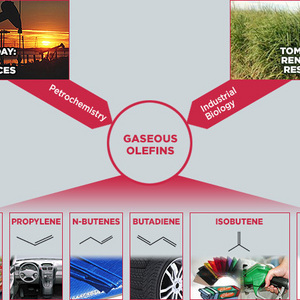Global Bioenergies produces isobutene from waste biomass




Global Bioenergies
March 4, 2015
BY Global Bioenergies
Global Bioenergies recently announced it has produced second generation isobutene, in a push to diversify accessible feedstock towards cheaper resources.
As a first step in its pioneering journey to manufacture biosourced isobutene, Global Bioenergies has been using first generation feedstock, such as wheat-derived glucose, to set-up and optimize its bioisobutene process. However, the process was designed to be versatile in terms of feedstock. With the right technical adaptations, it would indeed be well suited to the usage of nonedible resources—widely defined as second generation—such as wheat straw, corn stover, sugar cane bagasse or even wood chips.
Advertisement
Advertisement
Various companies are presently debottlenecking the conversion of second generation materials into fermentable sugars. These technologies have now matured to commercial scale, with five plants having started operations in the last 24 months. This industry ultimately has the potential to provide fermentation processes with low-cost sugars derived from abundant resources.
Global Bioenergies has recently established collaborations with nine companies from three continents developing the most promising technologies to convert various resources (straw, bagasse, wood…) into fermentable sugars. Preliminary tests have resulted in successful second generation isobutene production at the laboratory scale, with process performances similar to the ones observed using wheat-derived glucose.
Advertisement
Advertisement
Frédéric Pâques, chief operating officer at Global Bioenergies, comments, “We have now demonstrated experimentally that our isobutene production process is compatible with a range of second generation resources. Using impurity-containing sugar solutions is usually difficult in classical fermentation processes that lead to liquid compounds, because the accumulation of such impurities in the culture broth makes purifying the product more complex. Our process, which is based on the production of a gaseous product, alleviates these issues and will allow us to use the cheapest types of feedstock.”
Thomas Buhl, head of business development at Global Bioenergies, concludes, “Accessing second generation feedstocks strengthens the stunning perspective of our isobutene process to being massively used in the mid-term for the manufacturing of transportation fuels such as gasoline and jet fuel.
Related Stories
The U.S. Department of Energy Bioenergy Technologies Office (BETO) announced up to $23 million in funding to support research and development (R&D) of domestic chemicals and fuels from biomass and waste resources.
The U.S. DOE has announced its intent to issue funding to support high-impact research and development (R&D) projects in two priority areas: sustainable propane and renewable chemicals and algal system cultivation and preprocessing.
Sens. Sherrod Brown, D-Ohio, and Pete Ricketts, R-Neb., in August introduced the Renewable Chemicals Act, a bill that aims to create a tax credit to support the production of biobased chemicals.
The Chemical Catalysis for Bioenergy Consortium, a consortium of the U.S. DOE’s Bioenergy Technologies Office, has launched an effort that aims to gather community input on the development of new biomass processing facilities.
USDA on March 8 celebrated the second annual National Biobased Products Day, a celebration to raise public awareness of biobased products, their benefits and their contributions to the U.S. economy and rural communities.
Upcoming Events










